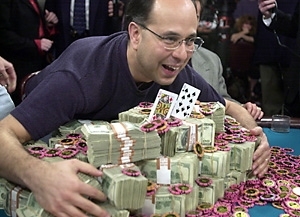Rob Varkonyi has always thought of his gambling losses as "educational expenses," but now they've helped him hit the jackpot.
As an MIT undergraduate on full financial aid, money was tight, but Varkonyi (S.B. 1983) never passed up an opportunity to learn something from the other poker-playing residents of Burton-Conner House. He might lose a few dollars here and there, but sometimes he walked away with $50, a tidy sum at the time.
"Poker may have been the most important thing I learned at MIT," Varkonyi says with a laugh, though serious.
Who would argue? His classes in computer science and management eventually led him to a good job on Wall Street, but the long nights of cards really paid off - he won the World Series of Poker in May, with a grand prize of $2 million.
Over five days, a field of more than 600 contestants played hand after hand of tense tournament poker at Binion's Horseshoe Casino in Las Vegas, hoping to reach the final table of nine players.
With a $10,000 entrance fee, the World Series attracts mostly high-rollers and professional gamblers. Varkonyi won his entrance fee in a preliminary competition, and though he had had his share of small victories, he wasn't considered a contender in the big event.
"About half the people there were full-time professionals and they just look at the other half as easy money," he said.
Determined not to be someone else's "easy money," Varkonyi poured all his concentration into every game he played, and every evening returned to his hotel room and collapsed from the day's exertions.
Varkonyi's friends J.P. Massar (S.B. 1978), a regular at the Burton-Conner House games, and Sue Solomon (S.B. 1986), were in town during the contest to provide coaching and moral support. Both bought a 1 percent share in Varkonyi's potential winnings for $100 and wound up with $20,000 apiece.
The final round of the World Series, played in front of more than 1,000 spectators and dozens of photographers and reporters, was a classic.
The "no limit hold-'em" game that was used in the tournament is, according to Varkonyi, "the Cadillac of poker games" because at any time, a player may bet all of his chips. To begin, players are dealt two private cards. Then five community cards are dealt at intervals into the center. Players must combine their private cards with the community cards to produce the highest possible hand.
In the end, seven of the nine players had been eliminated, leaving only Varkonyi and a British gentleman. His opponent was waiting for a card to complete a flush and, as luck would have it, the fifth and final community card (known as "the river") was exactly the card he was waiting for. He jumped in the air upon seeing it.
But as luck would have it, the same card also completed a winning full house for Varkonyi. "I crushed him like a bug," he said gleefully.
"After I won, some of the pros were saying that I was just lucky, but then I went and played the next tournament in Costa Rica and won that, too," said Varkonyi, who believes the game is 80 percent skill and 20 percent luck. "That week I was in the zone - absolutely focused and centered and, of course, lucky."
Since his win, Varkonyi has been enjoying his celebrity in the gambling world. On a recent trip to the Taj Mahal in Atlantic City, he was pulled aside and introduced to the proprietor, Donald Trump.
He's also at work on a book about his life and will be giving a poker master class in New York this fall.
As for the prize money, Varkonyi plans to save some of it, but he plans to devote a considerable portion to his continuing "education."
A version of this article appeared in MIT Tech Talk on August 14, 2002.






